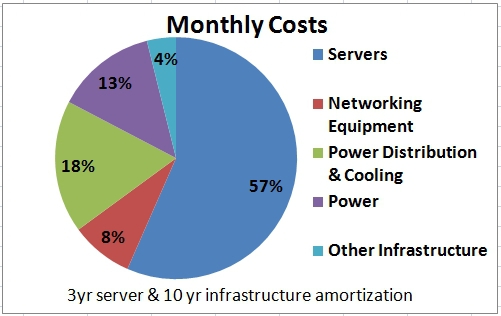AWS: Servers dictate datacentres' monthly costs

Servers are responsible for over half the monthly cost of running a large datacentre, according to a new model from Amazon Web Services' distinguished engineer James Hamilton.
Hamilton's model crunched the numbers on a 50,000-server facility, and found that after servers, a distant second for cost was the infrastructure required for power distribution and cooling, followed by power.
Due to a drive for efficiency in the way datacentres use power and the wide adoption of standards such as power usage efficiency, the power cost relative to the number of servers has been falling in facilities as well, according to Hamilton. Modern facilities can use less power for more servers, thanks to leaps in the efficiency of both infrastructure and server power tech, Hamilton wrote.

Credit: James Hamilton, AWS
The data knocks the view that the cost of the data centre building and infrastructure is what is most significant. "The key point to keep in mind is the amortization periods are completely different. Data centre amortization periods run from 10 to 15 years while server amortizations are typically in the three year range. Servers are purchased 3 to 5 times during the life of a datacentre so, when amortized properly, they continue to dominate the cost equation," Hamilton writes.
However, ZDNet UK believes that the amortization period for existing facilities could be higher than Hamilton estimates. A recent chat with Interxion's UK manager, Greg McCulloch, revealed that datacentre buildings have progressed in design to a point where new facilities should be built entirely from the ground up, rather than using existing, on-site shells. He also told ZDNet UK that Interxion has a rolling upgrade program on its existing facilities, to bring up the efficiency of their power distribution and cooling infrastructure. It is not clear whether Hamilton factors rolling capital upgrades, such as power and cooling infrastructure, into his monthly cost estimate.
The model includes all costs apart from the upper tier software layers — "below the operating system" — and also eschews licensing costs "mostly because open source is dominant in high-scale datacentres" and because of the level of pricing variation among among them, Hamilton says.
More data and a full breakdown is available here, on Hamilton's blog.